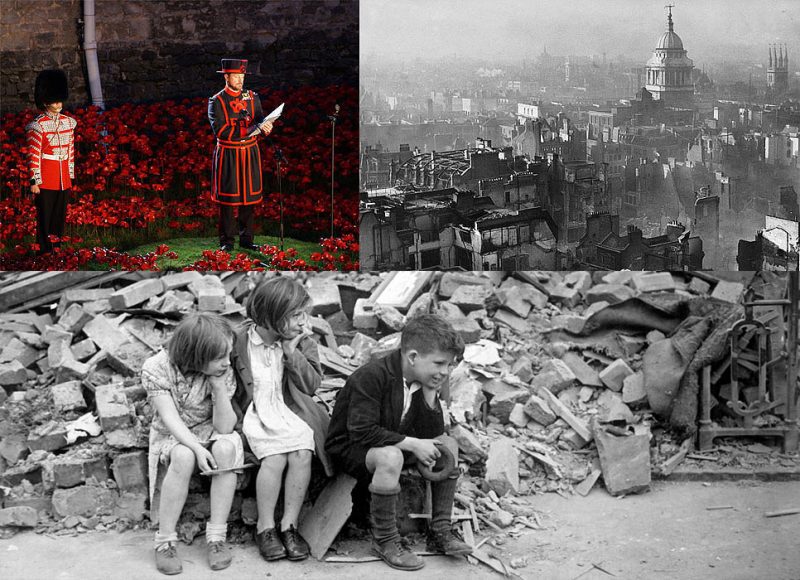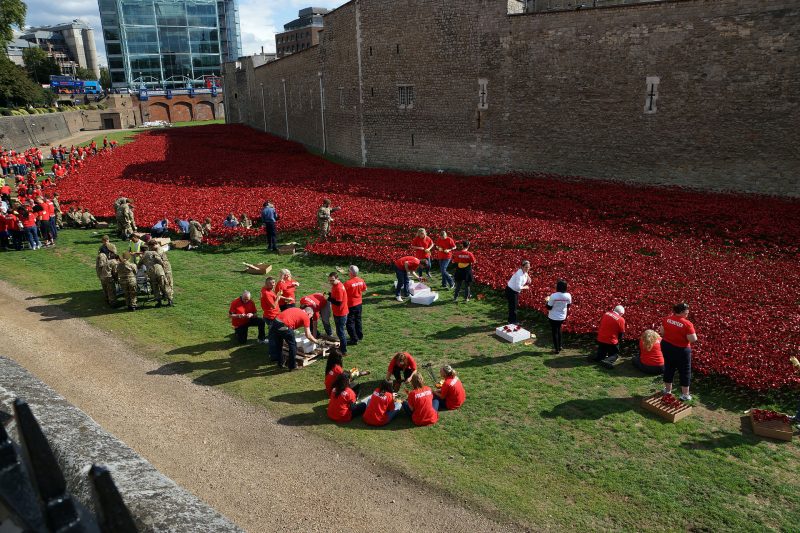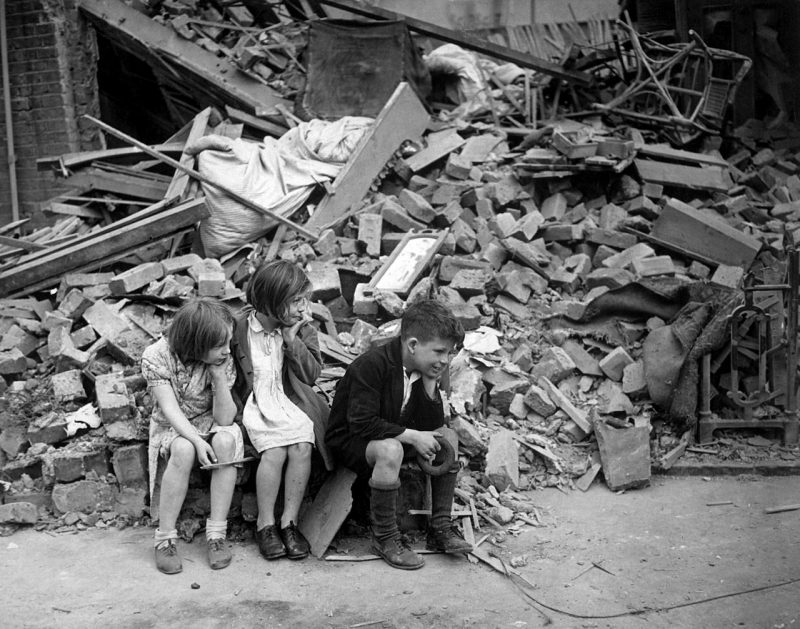Images Used (From Left): (1) Reading of the Roll of Honour by a Yeoman Warder as part of the WWI centenary commemoration in London between September and November 2014 (2) London after the ‘Blitz’ or strategic bombing of the UK by Nazi Germany between September 1940 and May 1941 (3) Children in East End of London made homeless by Nazi Blitz during WWII
Life has been extremely miserable and violent in many parts of the world this year. Last year was the year of remembrance for many Europeans; the Centenary of the WWI, which started in 2014 and the commemorations of the outbreak of the global warfare would continue till 2018. WWI is also known as the ‘Great War’. The public perception of the war being ‘Great’ indicates the enormous scale of the war and the term has also the moral connotations. The general feeling among the Allies is that they had been fighting against an Axis evil militarism. ‘Great War’ also carried the theme of Armageddon, the great biblical battle between the Good and the Evil to be fought during the end times. Other titles given to the conflict included ‘the Great War for Civilization’.
Besides articles, books, radio and television programs, around 5 million people visited the temporary art installation called ‘Blood Swept Lands & Seas of Red’ around the Tower of London as part of commemorating the centenary of the outbreak of WWI. 888,246 ceramic red poppies- one for every dead British & Colonial trooper- were planted by 17,500 volunteers to fill up the moat and the art installation remained in place between July and November 2014. The huge public turnout and the number of poppies provided a reminder that hardly any family in the United Kingdom was unaffected by the First World War. It is a deep-rooted folk memory. May 7 & 8, 2015 would see another milestone, the 70th anniversary of ‘Victory in Europe’ (V-E) day. May 10, 2015 will also mark the 75th anniversary of Churchill’s appointment as the PM of the United Kingdom. An implied difference between the first and second world wars is present. We often portray them as the Bad War and the Good War.
Image Used: Volunteers planting ceramic poppies in the temporary WWI centenary art installation ‘Blood Swept Lands & Seas of Red’ at the Tower of London
The WWI was fought between July 28, 1914 and November 11, 1918 and often the terms ‘the war to end wars’ and ‘a war to make the world safe for democracy’ had been falsely attributed to it. After the end of Second World War in 1945, Europe seemed to have finally achieved what had been promised in 1918. European countries did not fight each other for the next fifty years and cold war ended without any armies clashing in Europe.
As many as 18 million people died in WWI and over 70 million people died in WWII. Important difference was that up to 10 million or 55% of the total dead in WWI were combatants, while the horrible feature of the Second World War was that over 50 million or 71% of the total dead were civilians. This would be the true face of the WWII, also known as the Good War. This ‘Good War’ myth of the Second World War has been scrutinized by renowned British national daily, The Guardian.
The perception that WWII was nobler and finer than WWI is highly dubious, since such concept sanitizes so much, from the massacre of civilians by Allied bombings to the gang rape of millions of women by the Red Army at the time of victory. The sanctification of the later war has had more dangerous consequences than anathematizing the former. Worse than that is the glorification of the WWII and the assumption that the west is alone qualified and virtuous in distinguishing the political right from wrong. It is also not right to have the belief that our apparent virtuous ends must justify any means we apply, lighting up bomber flare paths in Dresden, Tripoli, Baghdad, Hiroshima and Nagasaki.
As the major European powers maintained a balance of power throughout Europe at the start of 1914, few expected another European war for real. Prolific British socialist journalist HN Brailsford stated in the spring of 1914 that there hadn’t been any possibility of any further wars among the six great powers. Even when Austrian Archduke Franz Ferdinand was assassinated in Sarajevo, everyone thought that Austria-Hungary’s declaration of war against Serbia and thus triggering of the First World War could be avoided.
Charles Edward Montague, lead writer & deputy editor of the Manchester Guardian, now the Guardian since 1959, was totally against the WWI before its commencement. However, appalled by the German treachery, he believed that one should join the war for a swift resolution. He was 47 and well over the age of enlistment. But he dyed his white hair black to fool the Army and got enlisted. A British war correspondent during WWI, H.W. Nevinson wrote that C.E. Montague was the only man he knew whose white hair had turned dark in a single night through ‘courage’. Every country was confident about a victory and expected a short war. The scale of the carnage became clear within weeks- when 27,000 French troopers were killed on August 23, 1914. Still confident of a short war, the Economist proclaimed that it was not economically or financially feasible to carry out the hostilities for many months on the ongoing scale. But the horrors continued for four more years on a larger scale and rulers of one country after another grasped human catastrophe and the grim political consequences. We should now look skeptically at the rhetoric of the ‘glorious dead’ who doesn’t ‘grow old’. The bereaved did not want to think that the death of their near and dear ones were in vein.
The forms of remembrance have been different in different countries. British memorials possess acute realism. Some remarkable works of gifted British sculptor Charles S. Jagger include the 1922 Great Western Railway War Memorial which is a bronze statue of a WWI soldier reading a letter from home and the 1925 Royal Artillery Memorial at Hyde Park Corner which depicts gunners dragging their guns through the mud.
The British Empire lost over 1.1 million soldiers and 80% of the dead were from the United Kingdom. The British considered that their losses were unimaginable while France, with a smaller population than the UK, lost over 1.4 million men and the dominant tone of war memorials in France is desolation. Pacifist war memorials were set up in some towns in France denouncing war with figures of children and widows rather than the combatants. One such famous memorial at Gentioux-Pigerolles in the Limousin region in central France has the inscriptions “À nos chers enfants” or ‘to our dear children’, followed by the names of the fallen, and then ‘maudite soit la guerre’ or ‘cursed be war’. Though controversial, such memorials suggested that these nations had lost the appetite for war. The First World War memorials in Germany were rather defiant than mournful. Some of the memorials listed the fallen and then ended with the words ‘Not one too many died for the Fatherland’ indicating that more efforts and sacrifices were required for a German victory. Another war memorial to the alumni of the University of Berlin who had been killed in the war bore the inscription ‘invictis victi victuri’ which means ‘to the unconquered from the conquered, who will themselves conquer’.
In the 1920s a good number of books have shaped our awareness and consciousness regarding war. Some of these were written by the English writers, such as- Goodbye to All That by Robert Graves, Memoirs of an Infantry Officer by Siegfried Sassoon, Undertones of War by Edmund Blunden, RC Sheriff’s play Journey’s End etc. An Australian novelist settled in England, Frederic Manning wrote Her Privates We. Erich Maria Remarque also wrote some famous German novels such as All Quiet on the Western Front (1929) and The Road Back (1931). These two novels with an anti-war theme by Remarque described the experiences of German soldiers during WWI. In 1933, Nazi propaganda minister Joseph Goebbels banned Remarque’s works and the writer had to leave Germany to live in Switzerland. ‘A Time to Love and a Time to Die’ (1954) and ‘The Black Obelisk’ (1957) were among his famous post WWII anti-war novels. English poet and soldier Wilfred Owen’s well known poem ‘anthem for doomed youth’ incorporates the theme of the horror of war.
Winston Churchill was also a critic of war’s misconducts. When he took part in the WWI, he was dismayed at the stalemate situation on the Western Front during the first months of fighting and he asked whether there were any other alternatives than sending out troops to ‘chew barbed wire in Flanders’. After the shifts in the perceptions of the Great War, another world war began and Churchill was at the center of it. In his first speech as the Prime Minister of the UK, he said that his policy was to wage war against a monstrous tyranny. And ‘the good war’ theme popped up soon.
WWII became quite glorious and was infused with high moral purposes. In contrast with the First World War, there were lots of war books and movies with a cheerful mood after the WWII. One reason was the British had suffered in WWII about half the casualties of the WWI. But this reason was a misleading one too.
The WWI Battle of the Somme was brutal enough where hundreds of thousands of riflemen had been going over the top together to face immediate death. However, combats were extremely severe for the combatants during the WWII battles- like during the Battle of El Alamein, Italian battles, Invasion of Normandy etc. The 1964 BBC documentary ‘The Great War’ included the testimony of men who had fought in the WWI and served in a British firing squad. The squad had 300 soldiers who executed the British soldiers for desertion and cowardice during the war.
The massacre of over 5.9 million Jews, around 78% of the total Jews in occupied Europe, wasn’t yet called the Holocaust. Austrian born American historian completed his great work ‘the Destruction of the European Jews’ in 1955. However, he had to wait till 1961 for a publisher to accept and publish it. That was the year when Nazi lieutenant colonel and one of the organizers of the Holocaust, Adolf Eichmann’s war crime trial began in Israel. Israeli national intelligence agency, Mossad captured him from Argentina in 1960. Eichmann was found guilty of his war crimes and hanged in 1962. Frankfurt Auschwitz trials also sentenced 22 Nazi personnel in 1965.
Image Used: Children in East End of London made homeless by Nazi Blitz during WWII
Stalin’s statement about the ‘Great War’ was remarkable. He rightly said that England had provided the time, America had provided the money and Russia had provided the blood. In the early part of the WWII, Britain defied Hitler but could not possibly defeat him, until he brought his own doom by invading Russia in June 1941. For most Americans, ‘the war’ meant the war against Imperial Japan. The obliteration of Hiroshima and Nagasaki was a highly debatable method for ending the WWII. The blood did flow freely in the East and 26 million Russians died including 9-14 million Russian Soldiers during the ‘good war’. The Nazi Germans butchered Jews wherever they went, and on the other hand, when the Red Army reached Germany it celebrated the victory with the worst act of mass rapes in the history of mankind.
More civilians than the soldiers were killed in the ‘good war’. Most distinctive British contribution to the war was the bombing that destroyed many cities of Germany and killed hundreds of thousands of Germans, mostly civilians and women and children. Our reverence for the ‘good war’ is a sentimental term. Our most recent ‘good wars’ include the 2003 invasion of Iraq and we had the idea that there hadn’t been any alternative but to participate in it. The overwhelming majority of those killed in Iraq since 2003 have been civilians and many of them were killed by western bombing. There is no such thing as a good war, but there may be necessary wars like the First and Second World Wars. We can’t, however, use the term ‘necessary’ about our latest wars.
https://www.youtube.com/watch?v=jfRq-JeUCSM
Video Used: 2 hour long documentary on the Second World War. Showing the brutal parts of the so called ‘Good War’; Graphic content warning


